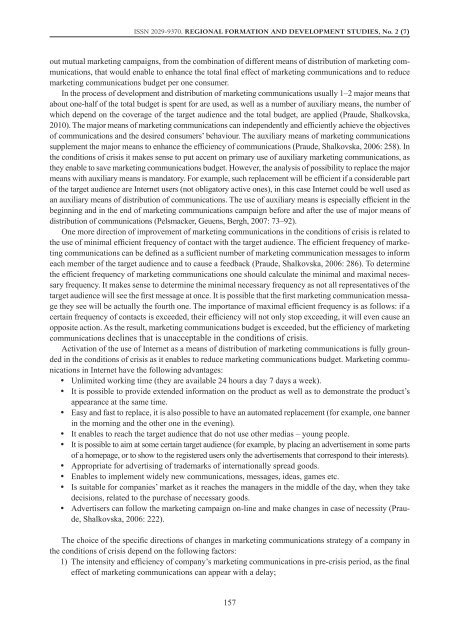regional formation and development studies - KlaipÄdos universitetas
regional formation and development studies - KlaipÄdos universitetas
regional formation and development studies - KlaipÄdos universitetas
Create successful ePaper yourself
Turn your PDF publications into a flip-book with our unique Google optimized e-Paper software.
ISSN 2029-9370. Regional Formation <strong>and</strong> Development Studies, No. 2 (7)<br />
out mutual marketing campaigns, from the combination of different means of distribution of marketing communications,<br />
that would enable to enhance the total final effect of marketing communications <strong>and</strong> to reduce<br />
marketing communications budget per one consumer.<br />
In the process of <strong>development</strong> <strong>and</strong> distribution of marketing communications usually 1–2 major means that<br />
about one-half of the total budget is spent for are used, as well as a number of auxiliary means, the number of<br />
which depend on the coverage of the target audience <strong>and</strong> the total budget, are applied (Praude, Shalkovska,<br />
2010). The major means of marketing communications can independently <strong>and</strong> efficiently achieve the objectives<br />
of communications <strong>and</strong> the desired consumers’ behaviour. The auxiliary means of marketing communications<br />
supplement the major means to enhance the efficiency of communications (Praude, Shalkovska, 2006: 258). In<br />
the conditions of crisis it makes sense to put accent on primary use of auxiliary marketing communications, as<br />
they enable to save marketing communications budget. However, the analysis of possibility to replace the major<br />
means with auxiliary means is m<strong>and</strong>atory. For example, such replacement will be efficient if a considerable part<br />
of the target audience are Internet users (not obligatory active ones), in this case Internet could be well used as<br />
an auxiliary means of distribution of communications. The use of auxiliary means is especially efficient in the<br />
beginning <strong>and</strong> in the end of marketing communications campaign before <strong>and</strong> after the use of major means of<br />
distribution of communications (Pelsmacker, Geuens, Bergh, 2007: 73–92).<br />
One more direction of improvement of marketing communications in the conditions of crisis is related to<br />
the use of minimal efficient frequency of contact with the target audience. The efficient frequency of marketing<br />
communications can be defined as a sufficient number of marketing communication messages to inform<br />
each member of the target audience <strong>and</strong> to cause a feedback (Praude, Shalkovska, 2006: 286). To determine<br />
the efficient frequency of marketing communications one should calculate the minimal <strong>and</strong> maximal necessary<br />
frequency. It makes sense to determine the minimal necessary frequency as not all representatives of the<br />
target audience will see the first message at once. It is possible that the first marketing communication message<br />
they see will be actually the fourth one. The importance of maximal efficient frequency is as follows: if a<br />
certain frequency of contacts is exceeded, their efficiency will not only stop exceeding, it will even cause an<br />
opposite action. As the result, marketing communications budget is exceeded, but the efficiency of marketing<br />
communications declines that is unacceptable in the conditions of crisis.<br />
Activation of the use of Internet as a means of distribution of marketing communications is fully grounded<br />
in the conditions of crisis as it enables to reduce marketing communications budget. Marketing communications<br />
in Internet have the following advantages:<br />
• y Unlimited working time (they are available 24 hours a day 7 days a week).<br />
• y It is possible to provide extended in<strong>formation</strong> on the product as well as to demonstrate the product’s<br />
appearance at the same time.<br />
• y Easy <strong>and</strong> fast to replace, it is also possible to have an automated replacement (for example, one banner<br />
in the morning <strong>and</strong> the other one in the evening).<br />
• y It enables to reach the target audience that do not use other medias – young people.<br />
• y It is possible to aim at some certain target audience (for example, by placing an advertisement in some parts<br />
of a homepage, or to show to the registered users only the advertisements that correspond to their interests).<br />
• y Appropriate for advertising of trademarks of internationally spread goods.<br />
• y Enables to implement widely new communications, messages, ideas, games etc.<br />
• y Is suitable for companies’ market as it reaches the managers in the middle of the day, when they take<br />
decisions, related to the purchase of necessary goods.<br />
• y Advertisers can follow the marketing campaign on-line <strong>and</strong> make changes in case of necessity (Praude,<br />
Shalkovska, 2006: 222).<br />
The choice of the specific directions of changes in marketing communications strategy of a company in<br />
the conditions of crisis depend on the following factors:<br />
1) The intensity <strong>and</strong> efficiency of company’s marketing communications in pre-crisis period, as the final<br />
effect of marketing communications can appear with a delay;<br />
157

















